Life And Its Diversity
Basic Properties Of Life
All activities of the living body are the result of the constant conversion of tr stored energy of the body (that stays at rest) into the kinetic one (i.e., the workable energy for the dynamic form).
- These activities are known as the characteristics of fife.
- Life is an energy-enriched substance that requires energy through the activities of a complex biochemical substance known as protoplasm
- which is provided with a system of self-equilibrium and helps the individual to adapt to the constantly changing environment to maintain a steady state.
- The term ‘Biology’ was first proposed by Lamarck and Treviranic
Life Can We Define It
Aristotle (384 – 322 B.C.), the great Greek philosopher, was the first to recognize pierce arc animals as living objects, but he failed to find a precise definition for life.
- The vital force that keeps the organism living, is life.
- It probably has no synonym. Life is abstract.
- Life is inseparable from the organism itself and fails to exist outside the living body.
- Hence, it is futile to attempt to define life.
- How life has come into existence on this earth
- What was the nature and characteristic of life at the time of its origin?
Read and Learn More Class 9 Life Science
The human mind has variously argued to find out the answer, since the inception of its civilization.
- Still, since Aristotle none has been able to try to give a precise definition of life.
- But, we all know that the activity of life is the expression of life and that is why we often use the term ‘lively’ to denote its activity. Aristotle is known as the ‘Father of Biology’.

Life is embodied in living organisms. It is often compared with the flame of a burning candle. The energy for such burning remains stored in the candle itself.
- The chemical phenomenon of burning or oxidation involves a rise in temperature in the surrounding medium.
- Heated particles are dispersed into violent vibrations which are manifested in the form of a flame that emits heat and light energies.
- Here, the flame is inseparable from the candle itself, since it persists only as long as the burning of the candle continues. Similarly, life persists only so long as the various lively activities of the organism continue. Again, the flame is extinguished when the candle-substance supplying energy to it is exhausted.
- Normally, life also ceases to exist when the stored energy of the living body is gradually spent up and not renewed. Hence, life and lively activities demand a continuous expenditure of energy like the constant expenditure of heat and light energies of the candle-substance to keep the flame ablaze. It is this energy that affords the power to work.
- It has two states of existence potential the stored energy that stays at rest, and kinetic, the other form is the workable energy for the dynamic form. Life, as such, involves a ceaseless conversion of the potential to kinetic form. Life shows some basic properties that are absent in non-living objects.
- Life shows the capacity to reproduce itself and can produce new life, they have the power to uptake and use energy can perform metabolism. They can also respond to external stimuli. Life is defined as the state of being alive manifested by growth, reproduction, and endowed with evolutionary potential.
Explanation of the basic properties of life with example
The characteristics of living organisms are the criteria of life. Some basic properties of life are cited below with examples.
1. Definite Form and Size: The shape of every living organism is definite (apart from a few exceptions example Amoeba). They maintain normal forms and activities irrespective of the changing environment.
2. Movement and Locomotion: Movement, concerned with protoplasmic movement only (in the case of unicellular organisms) and movement of different parts or organs of the body (in the case of multicellular organisms) are characteristic of living organisms. Protoplasmic movement is observed in Paramoecium (animal) and water-weed Vallisneria (plant).
- Observe the protoplasmic movement by taking a living Vallisneria leaf under a microscope note your observation and write down what you have observed.
- In higher animals definite and effective locomotory organs are present, such as fins of fishes, limbs of tetrapods, wings of birds, etc.
- while in unicellular animals pseudopodia (Amoeba), cilia (Paramoecium), and flagella (Euglena) are locomotory organelles that serve the purpose of locomotion.
3. Metabolism Definition: The total of the biochemical changes involved in a two-fold process of waste and repair of the protoplasm is known as metabolism.
- The constructive anabolic phase is the one in which complex substances are formed and the destructive, catabolic phase is the one where substances are broken down and discharged.
- These processes occur constantly within the protoplasm of living organisms, where uptake and use of energy occur.

- The constructive (repair) phase is one in which food materials are built up into more complex substances and the process is known as anabolism, (GK, Ana = upper, balls = throw), while the other phase (waste) is destructive, and is known as catabolism [cata = below, balls = throw).
- For instance, photosynthesis is an anabolic process in which sugar is formed in the cell and potential energy is captivated within the sugar molecule. Respiration is a catabolic process in which the captivated potential energy is released from the sugar molecule as kinetic energy with the oxidation of the sugar molecule.
4. Nutrition: The process of absorption of soluble food and its assimilation into protoplasmic substance, through many successive processes like ingestion, digestion, absorption, assimilation, and egestion is called nutrition which is a characteristic of living organisms.
5. Secretion: Enzymes and. hormones are two important secretory products taking part, in biological reactions influencing the overall metabolic activities of living organisms.
6. Transportation (Circulation): The living body has an organized seif-distribution system using which various substances are transported from one part to the other part of the body. In plants the transportable medium is water and in the case of animals, the transportation medium is water (lower animals example Hydra) and blood (higher animals).
7. Excretion: As a result of continuous metabolic processes going on in the protoplasm, various types of excretory products are produced which are mostly harmful to the body; these are commonly known as excretory products.
- These products are formed during the oxidation of organic food substances, hence, it is a catabolic process.
- Apart from carbon dioxide, these products are mostly nitrogenous substances, namely, Ammonia, Urea, and Uric acid.
- The process by which an organism is relieved of harmful excretory products is known as excretion.
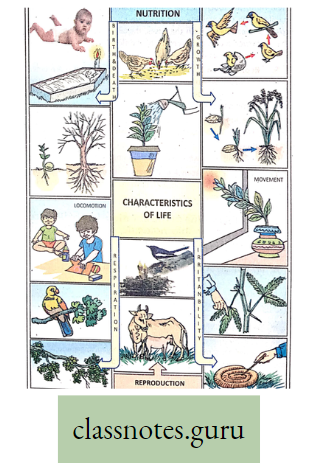
8. Irritability: The capacity to respond through internal changes to various exciting agents is commonly known as irritability. The changed environmental condition that excites and responds to the living organism is known as the stimulus, during which a living body reacts called a response.
- Thus the ability of the living body to respond to stimulus is known as irritability.
- The snail or any such animal, if disturbed by touch, usually withdraws its body within the shell.
- Here, the touch acts as a mechanical stimulus, and the withdrawal of the body is the manifestation of irritability.
- The sensitive plant Mimosa pudica (B. Lajjabati), when touched, closes the leaflets.
- In both cases, the organisms protect themselves from their enemies.
- The sunflower shows a movement of the flower cluster towards the sun which is a response towards the stimulus of light.
9. Reproduction: A living organism is capable of reproducing its kind.
- Thus, the mechanism of handing over life activities to new individuals from preceding ones is ordinarily called reproduction
- However, whatever the method of reproduction, the offspring resembles the parents when they attain maturity and gain a new life.
10. Heredity: The transference of characters from parents to offspring is called heredity which forms a characteristic of living organisms*.
11. Rhythmicity: Functional rhythm forms a basic property of protoplasm. All vital activities of living organisms follow a rhythmic sequence.
12. Life Cycle, senescence, and Death: The living organism is mortal with a variable limited life span.
The individual appears with birth from pre-existing living forms and grows, then attains maturity, reproduces offspring, gradually ages, and finally attains death.
A Brief Outline Of The Abiotic Origin Of Life Prebiotic Conditions
A brief outline of the abiotic origin of life on Earth:

Origin Of Life On Earth Definition: The process of gradual development of life from inanimate objects (non-living matter) spontaneously is called the origin of life. After the initial vibration of life, the simple form of organisms gradually becomes complex over time the process is known as organic evolution.
- Organic evolution is a slow but gradual progressive process where a simple form of the organism becomes complex over time through the process of reproduction, variation, and heredity.
- The whole concept of evolution can be summarised as “Omni Vivum Example Vivo” which signifies “All living forms have evolved from preexisting living forms”
- Various theories have been proposed to explain the origin of life on Earth of which theory of abiogenesis or chemical evolution is most acceptable. This theory can be explained in two ways. steps chemical evolution and biological evolution.
Chemical evolution (Chemogeny) Definition: The combination of different chemicals gradually to form organic polymers is called Chemical evolution.
1. The atomic phase: In the earliest history of Earth, there were numerous atoms of various elements like H, N, C, S, P, etc.
2. Formation of simple molecules: These free atoms combine to form simple molecules like H2, N2, CH4, H2O, NH3, CO2, etc. H2 and O2 combine to form H2O (water r vapor)—thus all O2 was exhausted. That’s why the atmosphere of primitive earth was free from O2 and the atmosphere was reducing atmosphere.
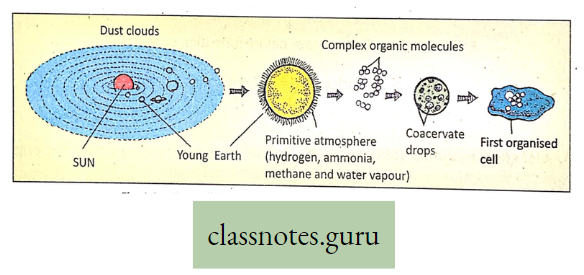
3. Formation of simple organic molecules or monomers: Different early molecules combined to form simple organic molecules like simple sugars (glucose, ribose, deoxyribose, pentose, etc.), nitrogenous bases (purines, pyrimidines), amino acid, fatty acid, glycerol, etc.
4. Torrential rain: Gradually water vapor formed clouds from where rainfall started. This rainwater dissolved various molecules (organic and inorganic) that moved into rivers, seas, and oceans.
- For various chemical reactions, energy is needed which is probably electrical energy (during thundershower and lightening), high energy radiation, solar radiation (UV-ray, X-ray, etc.)
- Oparin and Haldane (1924) called this mixture of dissolved molecules in the water a ‘prebiotic soup’ or ‘hot dilute soup.
5. Formation of complex organic molecules or Macromolecules: Various organic monomers like amino acids, fatty acids, hydrocarbons, etc.
- polymerized (in the presence of different energy sources as mentioned above) to form macromolecular polymers.
- Thus amino acids could form protein, monosaccharides form polysaccharides, fatty acids,s, and glycerol form fat.
- Similarly, nucleotides polymerized to form nucleic acid. In this way, different organic constituents of protoplasm probably evolved.
Do you know that probably evolved earlier to DNA?
Oparin Haldane Theory :
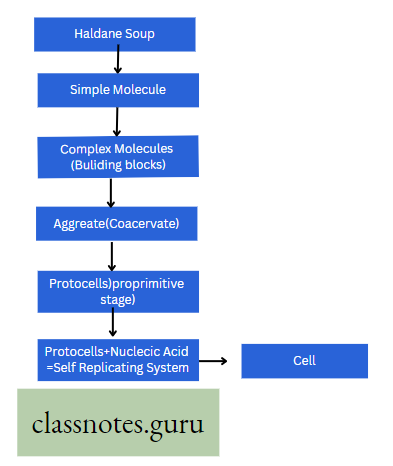
Biological evolution (Biogeny) Definition: The aggregation of different organic polymers to form primitive living cells is called biological evolution. Very high temperatures in early earth resulted in many chemical combinations to form varieties of biomolecules that were aggregated differently to develop the first living cell.
Different steps of biological evolution can be explained as follows:
1. Protobiont or Protocell or Eobiont: A protocell is a self-organized assembly of a spherical collection of lipids (in an orderly manner) which is supposed to be a stepping stone to the origin of life. Protocell has been explained in two ways :
Coacervate (Oparin and Haldane, 1920): Coacervate was defined as spherical aggregates ’ of colloidal droplets held together by hydrophobic forces. They measured approximately 1-100 micrometers. They lack a. definite membrane.

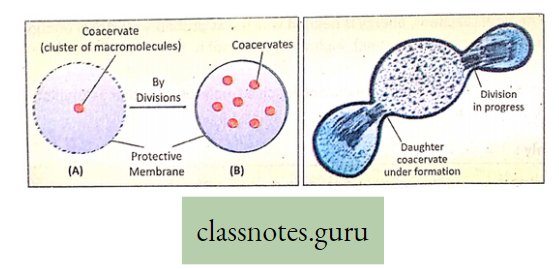
For reference only: The term coacervate is derived from the Latin word 1Coacervare’ which means “to assemble or cluster.” Oparin postulated that a protocell consisted of carbohydrates, protein, lipid, and nucleic acid that were accumulated together to form coacervate. This aggregate was covered by a film of water molecules.
Microsphere or proteinoid microsphere (Sidney Fox, 1964): Microsphere can be defined as spherical bodies, a few micrometers in diameter, formed of a mixture of amino acid molecules.
- They are soluble in water. A microsphere is a collection of nonliving organic macromolecules with a layered outer boundary that was not formed of lipids.
- This hypothesis was proposed by Sidney Fox who explained that early protocell was probably a microsphere.
- Microsphere is a collection of nonliving organic macromolecules with double-layered nonlipid outer boundaries.
- However, microspheres exhibited some membrane-like characteristics. They could absorb material from the surrounding medium.
- They had the ability of motility, growth, budding, binary fission, and capacity of reproduction by budding and fragmentation.
Some Scientists claimed that microspheres could be considered the first living cells
2. Origin of first living prokaryotes: Prokaryotes originated from protocells about 3-5 billion years ago in seawater. The atmosphere was anaerobic since there was no free 02 in the atmosphere.
- Prokaryotes are surrounded by membranes and cell walls. In the cytosol, there was nucleic acid but no nuclear membrane.
- Cytosol contains a mixture of various inorganic and organic materials—monomers, polymers, etc.
- Eukaryotes evolved from prokaryotes 1-5 billion years ago. They had various membranous and nonmembranous organelles.
- The nucleus was bounded by a nuclear membrane. Further complexity continued in the course of evolution.
A summary of the main steps in the origin of life under the Modern idea about the Origin of life :
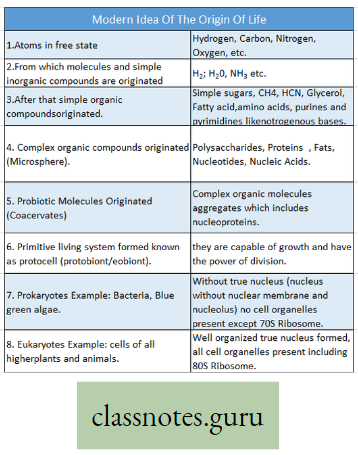
Sources Of Variations In Life
Variations are the differences noticed among the species on earth.
Variations are mainly of two types:
- Hereditary,
- Environmental.
- Hereditary variation: The variations or specialties or new characteristics that are inherited from parents to offspring (progeny) by genes are called hereditary variations. Thus genetic variations are transmitted from one generation to the next. This genetic variation (mutation) is the raw material of evolution that may give rise to new species over time.
- Environmental variation: Various special adaptive characteristics that develop in organisms in different environments are called environmental variations. These variations are generally temporary but sometimes may be inheritable.
During sexual reproduction, inheritable variations may be transmitted to the offspring. Thus more and more variation may develop generation after generation resulting in a diversity of life forms.
Biodiversity: The collection of diverse natural plants, animals, and microbes on earth L called biodiversity. There is an enormous variety of plants and animals on earth. Our earth ports more than one million species. This spectrum of biodiversity has been developed on earth over the last 3 billion years (300 crores years).
For reference only: Chart showing Geological Ages and Associated Organic Events or Evolutionary changes of plants and animals :
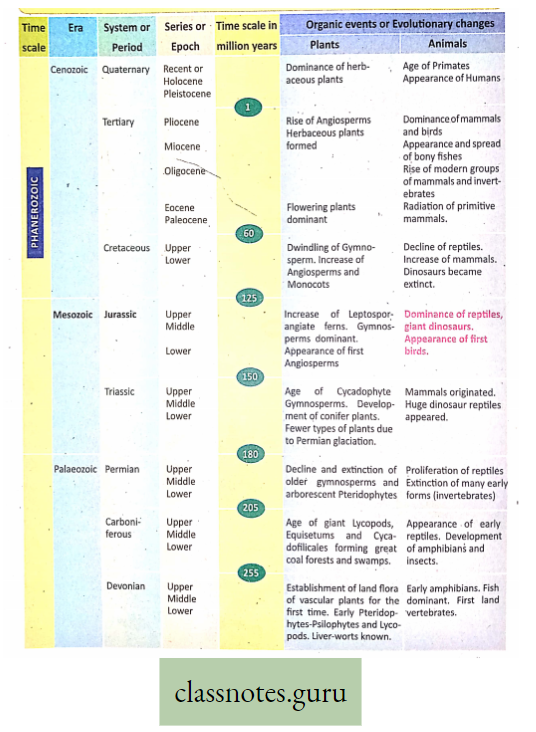
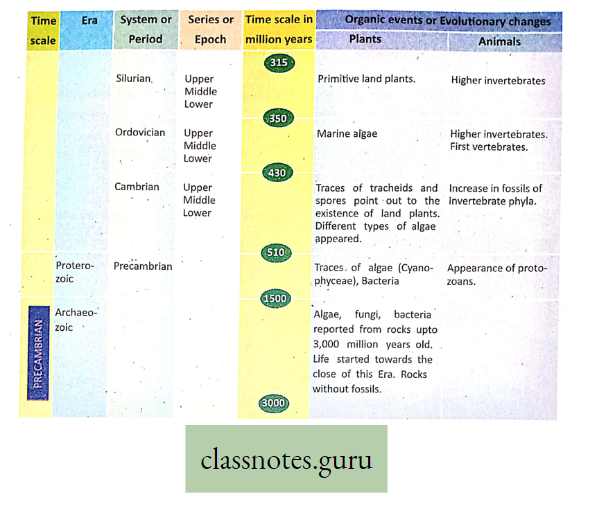
The chart shows the evolution of life:
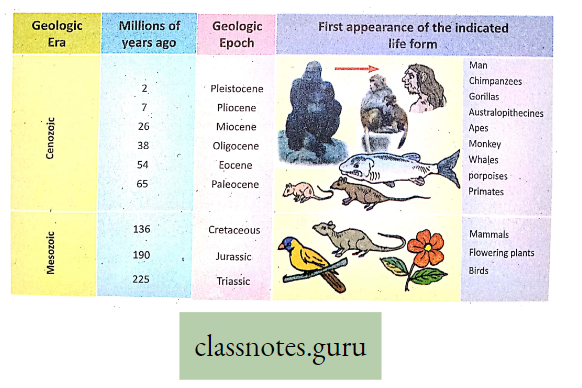
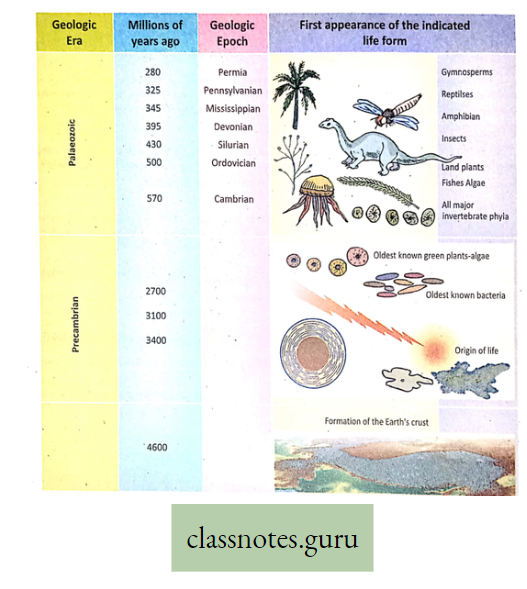
Biology Is The Study Of Patterns And Processes Of Life And Its Diversity
We study Biology for the following objectives:
- To awaken the pupil’s curiosity and interest in the plant, insect, and animal life around him in his environment. :
- To form in the pupil’s habit of accurate observation and of testing knowledge by experiment.
- To raise awareness in the pupils of the mutual interdependence of life forms in nature and.
their relationship with the environment as a whole. - To give pupils an intelligent and appreciative insight into the working of the life processes in nature’s kingdom…
- To kindle pupil’s love for animals (fauna) and plants (flora).
- To develop in the pupils of upper forms a spirit of research to enrich human life.
- To develop knowledge, information, and understanding about social problems which are essentially biological.
- To develop secular, liberal, scientific, and reasoning minds among the students.
- To develop the physical, mental, intellectual, and emotional aspects of the students in a balanced way.
- To develop a sense of cooperation and understanding among the different people in different parts of the country and among different countries about the balanced ’ distribution of natural wealth and resources.
- To develop understanding and awareness of pollution, conservation, and development of environmental resources. This is for sustainable development and to avoid wanton wastage of natural resources.
- To develop ideas of unity among people, the right to judicious exploitation of natural resources.
- To develop national integration and international understanding about Biodiversity, natural resources, and commonness about life processes and diversity in form and function thus promoting peace in the world perspective.
- The overall knowledge about the living world, distribution of natural resources, and man’s position in nature would help to develop the sense of a good citizen of a democratic country.
Biology is the science of life. It is the study of life in the case of humans, in other forms of animals together with plants. We study biology to come up with an idea about the structures and activities of different plants and animals. Biology is a basic science that helps us to know about the different activities of living organisms. The subject is also related to the environment. It gives an idea about the origin of life and explains its gradual evolution to develop ultimately various types of new plants and animals gradually.
Biological Studies At Different Levels And Aspects
Different branches of Biology :
- Biochemistry: Biochemistry (Biology and Chemistry)- It deals with the study of chemical substances and chemical processes of living things.
- Molecular Biology: The study of the structure and function of large molecules associated with living organisms particularly—proteins and nucleic acid (DNA and RNA). Molecular genetics is a specialized branch, concerned with the analysis of genes
- Immunology: The branch of science that deals with the responses of the body when challenged by antigen is referred to as immunology (immune = free) TEB
- Genetics: Genetics deals with heredity and variation. It tries to explain the mechanism by which the offspring resembles its parents. It also explains variations in plants and animals.
- Histology: Histology is the study of the microscopic structures that form the organ and their observations. This subject deals with the structures, functions, shapes, and sizes of cells and tissues of the living organism.
- Anatomy: The branch of science that deals with internal structures and organs after dissection is called anatomy.
- Physiology: It is the study of the different functions and activities that take place within the living organism. It deals with how the plant absorbs water by its roots and indicates the precise mechanism through which it is conducted to the different organs and finally to the leaves. Similarly, it deals with the functions of different organs in an animal body.
- Ecology: According to scientist Phillipson (1970) the branch of science that deals with the interrelationship between organism and surrounding environment is called ecology. German biologist E. Haeckel (1869) first proposed the term ‘ecology’, which is derived from the Greek word “Oikos” meaning “dwelling place or house” and “logos” meaning study. The term ecosystem was proposed by Tansley. The ecosystem is the unit of ecology.
- Behavioral biology: How someone or something behaves in the environment comes under behavioral study i.e. the sum of the responses of an organism to internal or external stimuli. Behavior is the change in activity of an organism in response to a stimulus. Behavioural biology (ethology), is the study of the biological and evolutionary bases for such changes.
Pavlov’s Experiment: Pavlovi used to give some food to a dog. Usually, the dog salivated to eat the food. He sounded a bell which had nothing to do in salivation.
- However, the continued association of the bell with the food caused salivation not only in response to the food but also to the sound of the bell.
- So later on, when only the bell is rung, without giving food, the dog salivates.
- This shows that the reflex of salivation is acquired by the dog as a result of repeated training. This is an example of conditioned reflex.

Behavior of honeybee : (Honeybee is a social insect) Worker bees flap their wings to cool a bee hive and huddle together to warm a bee hive.
- They can maintain a constant temperature in the bee hive. Forager bees can locate foraging grounds and communicate about the location with their colony mates through round dance and waggle dance.
- Workers showing helping behavior between members is called altruism meaning self-sacrifice.
- There are three types of honey bees Queen (fertile female), Worker (sterile female), and drones (fertile male).
10. Evolution: Organic evolution means a gradual progressive but dynamic process where a simple form of organism gradually becomes complex with time by the process of reproduction, accompanied by variation and heredity. For example, the evolution of vertebrates can be explained :
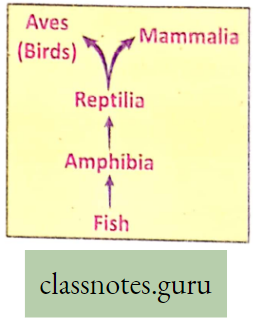
Other branches of biology :
- Palaeontology: (Palaeos = primitive; ont = existence; logos = discourse). This is the brand) of science that deals with the study of fossils. The present-day distribution of plants and animals does not conform to their ancient distribution. The extinct plants and animals of prehistoric ages when preserved under different geological strata are called fossils.
- Economic Biology: This branch of Biology deals with the economic or utilitarian aspect of the subject. Examples: Peorlculture with pearl oysters, Apiculture with honey bees, Sericulture with silkworms, Pisciculture with fishes, Poultry birds, Dairy animals, crops, etc.
- Cytology: This deals with the study of cells.
- Microbiology: It is the study of organisms that are too small i.e. an object which have a diameter of less than 0-1 mm. They can be studied only under a microscope. Microorganisms include some metazoan animals, protozoans, many algae, fungi, bacteria, and viruses.
- Taxonomy: It is the study of the classification of plants and animals based on their relationship, resemblances, and differences. The apparent dissimilarity between two organisms does not rule out the possibility of their actual basic closer relationship (for example caterpillar and butterfly). On the other hand, the apparent similarity between two organisms does not necessarily signify their actual kinship (for example bird and bat).
- Pathology: Pathology deals with the nature, symptoms, and causes (pathogens) of different diseases in plants and animals. It tries to point out their prevention and remedies.
- Major divisions of Biology :
- Botany (Botane – Herbs) and Zoology (Zoon = Animal) are the major sister branches of Biology.
- Botany: Botany deals with the plant world. It is further sub-divided into Bacteriology (bacterium – a little rod) which deals with the study of microbes (bacteria); Agrostology, dealing with the study of grass and the like; Dendrology, dealing with the trees; Mycology, dealing with the Fungi; Palaeobotany dealing with the plant fossils, etc.
- Zoology: Zoology deals with the animals. It has also many sub-divisions, namely, Protozoology, dealing with unicellular animals; Helminthology, dealing with parasitic worms; Entomology, (entomon = an insect) dealing with insects Malacology, dealing with mollusks; Ornithology, dealing with the waves.
- Further, Palaeontology deals with animal fossils; Fisheries, in a broader sense is concerned with the exploitation of the water resources of animals, etc.
- Likewise, Anthropology (anthropoids = a man) is concerned with the study of various races of mankind. Biogeography deals with the geographical distribution of plants and animals on Earth.
Infusions Of Knowledge From Other Branches Of Science Into Biology
No branch of science is independent. The various facts and the variety of knowledge drawn from every branch of science nourish each other branch to develop. Fundamentally Biology is a vast division of science that is concerned with the entire organic world and tries to seek the relation between the inorganic and living things. In its endeavor, it requires various knowledge of the Physical sciences of physics, chemistry, and mathematics (including statistics).
For an intimate understanding of the fundamental life processes Biology has combined with various branches of science to form the following new subjects:

- Bio-Physics (Biology+Physics): It is Concerned With the application of physics to the study m), EEG (Electroencephalogram), MRI (Magnetic Resonance Imaging), CT Scan (Computerised Tomography), USG (Ultrasonography), etc.
- Bio-Chemistry (Biology + Chemistry): It is concerned with the application of chemistry to the study of living things.
- Bio-Mathematics (Biology+Mathematics): It is concerned with the application of mathematics to the study of living things.
- Biometry (Biology + Statistics): It is particularly concerned with the statistical study of related organisms, e.g. statistics of variations.
- Bioinformatics: An important aspect of Biological Sciences is the Intugmtlon of Biology with tho Inloi million technology computers to form a subject culled blolnlonnnlliv,
- Bio-geography (Biology + Geography): I bis division Is Concerned With studying the global dKtilhutloo of plants and animals.
- Bionics(Biology + Electronics) deals with the study of molecular phenomena revealed within the parameters of electronics.
- Paleontology (Biology I Geology): It deals with the study of fossils and is sub-divided Into two parts inilucoboUwy (dealing with plant fossils) and the other, paleozoology [dealing with animal loss), Do I still give in? Impression of the hard part of the body.
- Marine Biology (Biology + Ocenogiaphy): It deals with the flora (Plants) and fauna (Animals) of the coastal area and the application of methods to check erosion of the soil and maintain proper ecological balance.
- Space Biology (Biology + Space Science) Or Exobiology: It deals with the condition of living objects in space under various experimental treatments.
- Cytogenetics (Biology + Genetics): It deals with integrating the methods and findings of cytology and genetics.
- Cybernetics (Biology + Technology): It deals with the application of various technological devices for biological systems.
- Biomedical Engineering: Biomedical Engineering is a branch of science that deals with the designing of different medical instruments and information providing knowledge about their production. Knowledge of this technology is used in the production of artificial limbs, implants, artificial heart valves, etc.
The emergence of new branches of Biology: Biology has enormous applications in other branches of science. It forms an important part of
- Veterinary science: It deals with the treatment and surgery of animals.
- Marine biology: It deals with the study of life in the sea.
- Horticulture: It deals with the science of growing flowers, fruits, vegetables, and ornamental plants.
- Sericulture: It is the technique of producing silk by rearing silkworms. Silk is made of two types of protein Outer layer Sericin and inner layer Fibroin.
- Pisciculture: It deals with the technique of growing fish. Aquaculture→Fishery → Pisciculture. Aquaculture means the culture of all aquatic beneficial plants and animals. Fishery means a culture of beneficial aquatic animals (both fish and non-fish) only like prawns, crabs, fish, pearl oysters, dolphins, whales, etc. Pisciculture means a culture of fish only.
- Cloning: It is the rapidly advancing branch of biotechnology introducing a body cell for producing an individual.
- Molecular biology: It is the science that deals with interpreting biological events in terms of the molecules in the cell.
- Biotechnology: it deals with the application of technology in biological processes such as biogas production from organic wastes—(for example Gobar gas plant); and the production of insulin through bacteria.
- Nuclear biology: It is the study effects of radioactivity on living things, for example, the Radiation of gamma rays in cancer patients.
Applications Of Modern Biology
Biology is the study of living organisms considering all aspects of the structure and function of organs, behaviour, and all life processes, that are found to occur.
- The advent of biological science started with the discovery of a microscope which allowed detailed observation of cells and cell organelles.
- The study of cell and cell components at the molecular level is very much essential to understanding the underlying mechanism of their function.
- Ultramicroscopy or electron microscopy provides visualization of the detailed structure of ceil and its components at the molecular level.
- The mechanism of all cellular phenomena should be studied at the molecular level to understand the actual mechanism underlying these processes.
1. Application of Biology in Agriculture: It is a form of applied biology. Agriculture in reality is largely the result of man’s taking advantage of the inter-relations of soil, climate, and natural inhabitants to select those particular combinations that meet his requirements. It deals with the raising of crops and livestock.
- In the production and protection of food and its improvement: Better varieties of crop plants such as rice, wheat, jute, sugarcane, pulses, and cotton are new experimental breeds. Disease-resistant grains are raised and seeds are vernalized by special treatment to yield the crop before the usual time of harvesting. Soil is saved from exhaustion by crop rotation. Plant diseases are cured by using preventive measures.
- Hybridization techniques: Hybridization techniques and modern methods of cultivation are being used for the production of new varieties of economically important plants like HYV (High Yielding Varieties) of plants, dairy animals, and poultry birds; use of disease-resistant varieties to increase crop production.
- Example: Paddy—IR8, Taichung, etc.; Wheat—Kalyansona; Poultry bird—Leghorn, Rhode Island Diary animals Jersy cow.
2. Application of Biology in Medicine: Discovery of antibiotics like Penicillin, Streptomycin, and Cloromycetin has helped to combat many life-threatening diseases.
- Penicillin is used to cure pneumonia and some other diseases.
- Insulin and human growth hormone are produced from genetically engineered bacteria with recombined DNA and are useful for the treatment of diabetes Mellitus and dwarfism respectively.
- The practice of vaccination is also an outcome of biological knowledge.
- Some medicines are prepared from inorganic products but the science of Ayurveda utilizing vast natural resources for the treatment of several diseases is an outcome of biological knowledge. Vaccination and inoculations are done to prevent diseases of many kinds.
3. Application of Biology in Space Science: The role of biology has become important in space research. The green algae Chlorella was kept in a spaceship to provide a constant supply of oxygen to the cosmonauts. The dried Chlorella is also consumed as food.
4. Application of Biology in other fields :
- Genetic engineering or biotechnology has a lot of applications like the synthesis of insulin and somatotrophic hormone) and various other useful biomolecules.
- Hybridization technique helps to produce varieties of HYV plants and animals, disease
resistant plants. - Use of bacteria for the treatment of sewage and domestic wastes; production of biogas (Gobar gas plant) as an alternative source of energy.
- Gene cloning, and tissue culture techniques have a lot of applications.
- DNA fingerprinting technique is extremely useful in forensic research.
- So many other important modern biological techniques that have tremendous applications in our lives are—Gene therapy, Genetic counseling, amniocentesis, production of monoclonal antibodies, and so on.

Classification Of Diversity Of Life Taxonomy
Earth is full of millions of different kinds of organisms at present and many millions more existed in the past and became extinct. The number of species living on earth comprises its overall biodiversity that changes over time as a result of both adaptive radiation and extinction. Biodiversity is the result of 3-5 billion years of evolution.
- Diversity characterizes most living organisms. There is an enormous variety of plants and animals on the Earth, and the high degree of species richness in tropical forests and coral reefs is a matter of marvel.
- Our Earth supports 10-30 million species of plants and animals. The diversity is due to the result of the continuous process of evolution extending over 3 billion years.
- The variety of life on earth that includes all species of plants, animals, and microbes along with the ecosystems within which they live and interact are together known as biodiversity.
- “Taxonomy is a science which includes identification, nomenclature and classification object; and is usually restricted to objects of biological origin”
Why organisms are classified: Various living organisms in this biosphere exhibit great diversity in shape, size, and form. The study of every individual separately is impossible. So, diverse forms of living organisms are classified orderly for ‘group study’.
A Very Brief History Regarding The Birth Of Modern Taxonomy Till Linnaeus
- Development of modern taxonomy in Europe when naturalists started encountering a high diversity of new living organisms, especially from the tropics—
- In the above pretext a very brief history regarding the birth of modern taxonomy till Carolus Linnaeus is stated below—
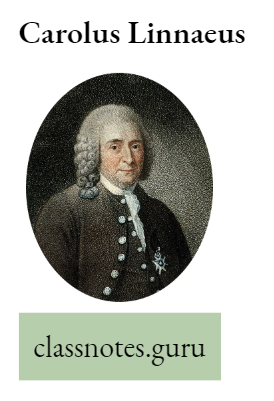
Based on habit characteristics the grouping of plants into herbs, undershrubs, shrubs, and trees was done by the Greek naturalist Theophrastus (370-285 B.C.). He was a student of Aristotle a Greek Philosopher and was known as the “Father of Botany”. Before the start of the Christian era, a compilation work done by Paraso in Vrikshayurveda is considered one of the earliest works done by an Indian, which deals with plants in a very scientific way.
His system of classification was based mainly on comparative morphology. Charaka considered the father of Ayurveda, described 200 kinds of animals and 340 kinds of plants, which was published in his outstanding book ‘Charak Samhita’. Similarly, Susruta was a famous surgeon.in ancient India.
For reference only: Jolm Ray (1628-1705), was an English philosopher, whose classification was based on an unusual mixture of old and new.
- He retained the method of earliest grouping of plants into herbs, shrubs, and trees as the principal division.
- He introduced the ‘key’ method of classification. He recognized monocots and dicots within the above groups.
- Further, he divided these taxa considering the characters of fruit and still further subdivided them based on leaf and flower characters, Ray’s system of classification was based on the form and overall morphological structures of different plants.
- The major groups are
Herbal (herbs)
- Imperfect (plants without flowers) Cryptogams
- Perfectae (plants with flowers Phanerogams)
Dicotyledons (Seeds with two cotyledons) and Monocotyledons (Seeds with one cotyledon)
Arborae (includes trees and shrubs)
- Dicotyledones
- Monocotyledones
The term species was first introduced by John Ray. He described various kinds of plant species collected from all over Europe. The famous Swedish naturalist Carolus Linnaeus (1707-1778) classified plants and animals, which though artificial, is considered the father of modern classification. He first introduced the scientific system of naming of plants and animals, a method known as binomial nomenclature.
For reference only: Linnaeus plant classification is based on sexual reproductive organs like, the number of stamens and carpels, etc.
- So, his system of classification is also called sexual classification. He divided: the plant kingdom into 24 classes of which the first class is Monandria and the last class is Cryptogamia.
- Linnaeus divided the animal kingdom into six. classes, like :
- Mammalia,
- Aves,
- Amphibia,
- Pisces,
- Insecta,
- Virus.
Carolus Linnaeus recorded about 5900 species of plants in his published book ‘Species Plantarum’ (1753) and nearly 4200 species of animals in his, ‘Systema Naturae (1758). Linnaeus is known as the ‘Father of Taxonomy’. The term ‘taxonomy’ was first proposed by Candolle. In animals, instead of division, the term ‘Phylum’ is used.
Taxonomy And Taxonomic Hierarchical Arrangement Of Classified Groups
The hierarchy is the systematic framework of classification formed by the arrangement of taxonomic groups in a definite order starting from the higher category to the lower category.
In a classification of plants, the categories are Kingdom, Division, Class, Order, Family, Genus, and Species.
- The lowest category is species and the highest category is the Kingdom. Since the time of Linnaeus, the first taxonomist who established a definite hierarchy, the number of known animals (species) has increased enormously.
- Thus, the original basic categories have been split and additional ones have been accommodated among them.
- In the process, several subgroups have been established by combining the prefixes super or sub- with the original category names; for example, order and super-order, family, and sub-family may be mentioned.
- Further, a new category has been imposed between genus and family known as tribe and between order and class, known as cohort, while below sub-class and sub-orders infra-class and infra-orders respectively are used.
Steps Of Linnaeus’s Hierarchy
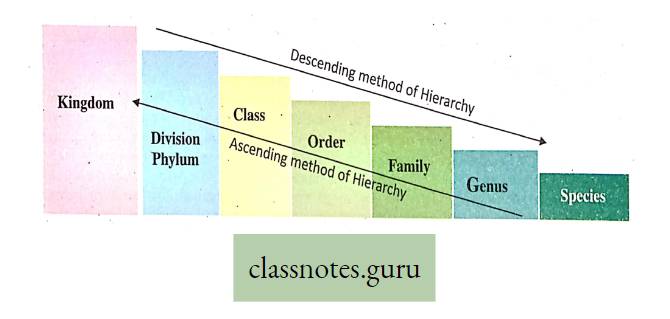
Any particular level in hierarchy classification is called a taxon (PI. Taxa).
- species is a group of individuals exhibiting similar morphological character that breeds to produce their kind. It is the lowest step in hierarchy classification.
- Genus: It is the term given to a group of closely related species.
- Family: It represents a group of genera that show more similarity to each other.
- Order: It represents a group of families showing resemblances in only a few characters.
- Class: It represents organisms of related orders.
- Division (Phylum): The Kingdom is divided into divisions until plants are placed in the final taxon the plant kingdom and into phylum in cases of Animal Kingdom.
- Kingdom: It is the highest category of classification including all organisms which share marked common characters. All plants are placed under the Plant Kingdom.

For reference only Examples: The Taxonomic categories of ‘Mango’ and ‘Man’ are stated below :
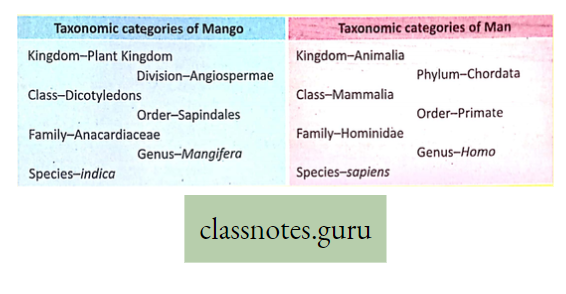
Binomial Nomenclature
Nomenclature may be defined as a system for assigning names to organisms. The Binomial system of Nomenclature was introduced by Swedish Biologist Carolus Linnaeus in the first edition of his “Species Plantarum” in 1753.
- According to this system, the scientific name of any species consists of two Latin or Latinized words. The term binomial means, L. ‘bi’ means ‘two’, and means ‘name’.
- The first name is the name of the genus, i.e., generic name and the second name is the name of the species, specific epithet.
- For example, the botanical name of paddy is Oryzo sotiva. The first word ‘Oryza’ is the name of the genus and the second word ‘Sativa’ is the name of the species of this genus.
Rules of Nomenclature: The following conventions of nomenclature may be noteworthy :
- Names given to plants or animals before the publication of ‘ Systema Nature (10th edition) are not acceptable.
- Names should be written in Latin or its derivative.
- Both the generic and specific names (epithet) must be written in Italics, the genus
starts with a capital letter and the species begins with a small letter, for example, Solanum tuberosum (Potato). - The specific name is usually a descriptive one, for example, Hygrophilia spinosa a plant with
- Only a single valid name for each kind of organism is permitted. When two or more names are given correctly to a plant or animal, then the name used by the first author (the author who described the plant or animal first) is approved and the others would be treated as synonyms. This is known as the Law of Priority.
- Scientific names must have a significant meaning which is the most salient feature of the organism.
- The name of the author who first described a species is also added to an abbreviated form after the name of the species for example, Mangifero indica Linn, Here Linn refers to the author Linnaeus who first described the species.
- In the case of animals, the suffix-effixes must be added to the family name and the suffix-effixes to the sub-family name.
For reference only: A list containing the names of certain plants and animals is given below
- National flower of India (Lotus): Nelumbo nuclear
- National fruit of India (Mango): Manglfera indict
- The national bird of India (Peacock): Pavo status
- National animal of India (Tiger): Panthcra tigres
Classification system up to Five Kingdoms of Life:
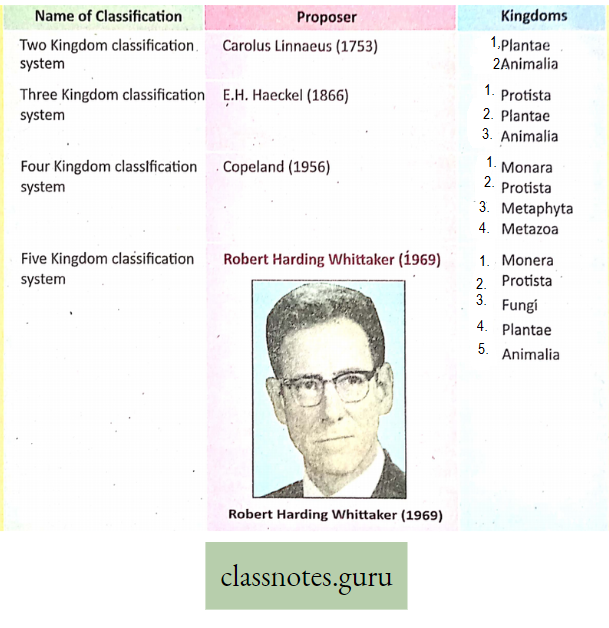
Five Kingdoms of Life
The most accepted one is the Five Kingdom System as proposed by R. Whittaker (1969).
- Various experts at different times classified all the living organisms under the kingdom, the largest taxonomic hierarchy virus
- containing only DNA or RNA as genetic material is not included under any scheme of classification.
- They do not possess cell walls and are without cytoplasm.
- They can perform reproduction only by invading the living cells.
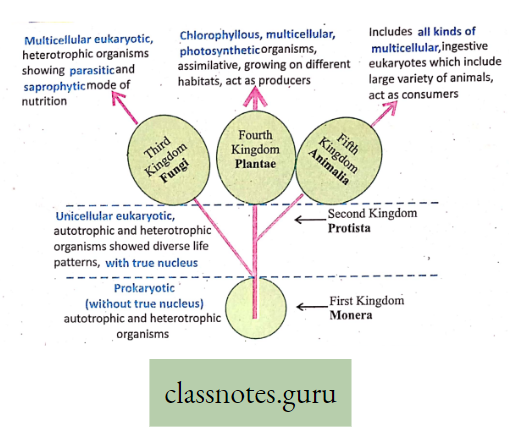
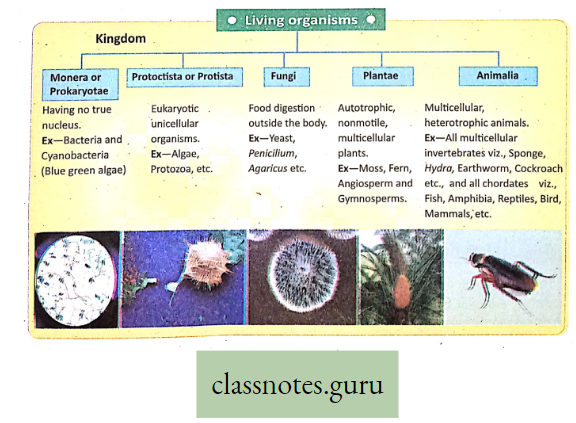
For reference only :
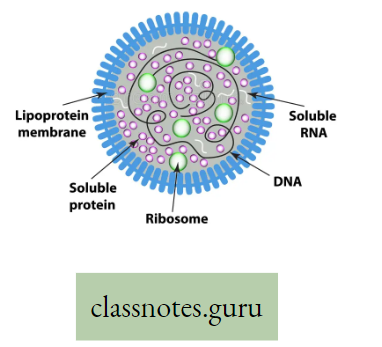
- A monerian is Mycoplasma. They do not possess rigid cell walls.
- They are the smallest living organisms with a diameter of 0-1 MB
- Through the bacterial filter, they can be filterable, easily, which signifies their similarity with the virus.
- They can change their shape and size (exhibiting polymorphism) concerning variations in conditions of the environment a phenomenon termed as pleomorphism.
The five Kingdoms of life were
- Monera: This includes prokaryotic, autotrophic, and heterotrophic living organisms.
- Protista: This includes eukaryotic, unicellular, and both autotrophic and heterotrophic organisms.
- Fungi: This includes eukaryotic, multicellular both autotrophic and heterotrophic organisms which show sporulation and absorptive mode of nutrition.
- Plantae: This includes multicellular plants that have the power of photosynthesis, they develop on land or water.
- Animalia: This includes multicellular eukaryotes with ingestive or holozoic mode of nutrition (five phases—ingestion, digestion, absorption, assimilation, egestion).
- This kingdom includes all the motile and sessile animals.
Three Salient Features Of Each Kingdom
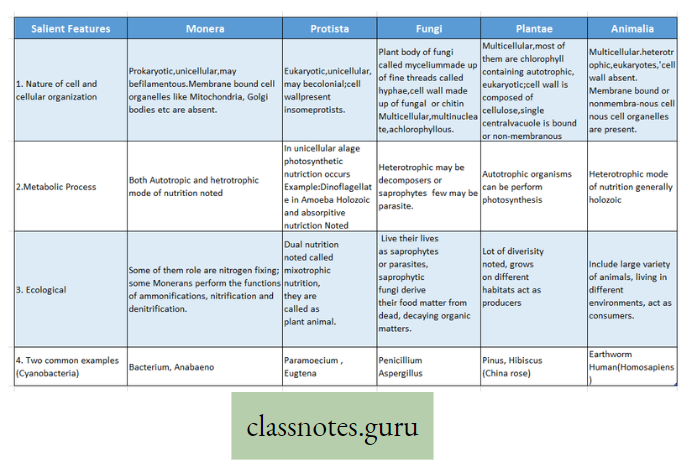




For reference only: Margulis and Schwartz in the year 1982, revised the five-kingdom classification as proposed by I R. Whittaker into one prokaryotic kingdom (Prokaryotae) and four eukaryotic kingdoms.
- The former includes Prokaryotae (Kingdom 1 Monera) and the latter includes four eukaryotic kingdoms (Eukaryotae) Protoctista, Fungi, Plantae, and Animalia.
- The collection of the diverse nature of plants, animals, and microbes on the earth’s surface is called diversity.
- The word Bio-diversity was first coined by Walter Rosen in 1986.
- In India, it is estimated that 45,000 spp. of plants occur including 18,000 spp. of vascular plants. Among animals, there are 50,000 spp. of insects, 4,000 mollusks, 6,500 other invertebrates, 2000 fish, 140 amphibians, 420 reptiles, 1200 binds, and 340 animals. The current loss of species diversity and the reduction in genetic variety of crops and wild spp. could seriously affect human welfare.
For reference only:
Facts to know: Biodiversity is a term given to the diversity of life forms found in a specific area.
Major groups of plant kingdoms: Algae, Bryophyta, Pteridophyta, Gymnosperm, and Angiosperm (Monocotyledon and Dicotyledon).
Classification of Kingdom Plantae
Nowadays in many cases plants. the kingdom is classified considering the major groups :

The Plant Kingdom is mainly divided into the following two groups: Cryptogams and Phanerogams.
Non-flowering plants or [Cryptogams] Definition: These plants do not bear flowers, hence no formation of fruits and seeds, and are termed as Nonflowering plants or Cryptogams. The word Cryptogam is derived from two Greek words, for example, Kryptos Concealed, and games = marriage. Non-flowering plants are divided into three classes
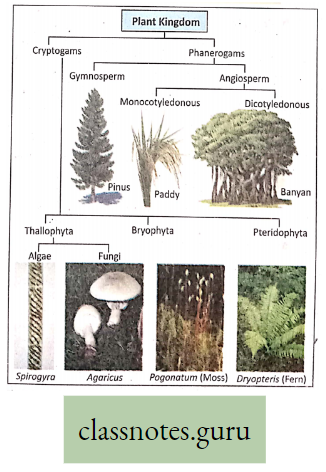
Thallophyta:
- The plants included under very simple.
- Their body is not differentiated “ into root, stem, and leaves.
- Their body is composed of a mass of cells called haikus. Hence, they are termed as thallophytic plants. Plants under Thallophyta are again divided into two groups
- Example Algae and Fungi.
Algae :
- As their body cells contain chlorophyll, hence they can prepare their food.
- They are present in moist swampy places, ponds, jheels, etc.
- Examples—Spirogyra (filamentous), Chlamydomonas (unicellular), Volvox (colonial), Chara (green algae) Fucus, Laminaria [brown algae); Polysiphonia (red alga) etc.
Fungi :
- They do not bear chlorophyll, so are colourless
- The plant body is made up of filaments called hyphae (sing, hypha).
- Hyphae collectively form mycelium,
- They are mainly parasites and saprophytes,
- They occur in rotten bread, fruits, leather, jam, jelly, cow dung, etc.
- Their cell wall contains chitin (Nitrogenous polysaccharide).
- Examples— Mucor, Rhizopus, Penicillium, Saccharomyces (commonly called Yeast), Agaricus (Mushroom), and Helminthosporium. etc.
Difference between Algae and Fungi:

In the 5 Kingdom classification Fungi are placed in separate kingdoms (third Kingdom): BryophyCa (Ct Bryon, moss; faction, plant):
- The adult plant body is a haploid gametophyte. The plant body is either. thallus-like or differentiated into root-like (Rhizoid), stem-like (Cauloid), and leaf-like (Phylloid).
- No true root stem or leaf is present,
- The plant tissues contain chlorophyll and thus are capable of preparing their food,
- They do not possess conducting channels in vascular tissues,
- They usually occur in moist swampy places, for example, Riccia, Marchantia, Notothylas, Pogonatum, Polytrichum, etc.
Curious Facts:
- Among all the existing living organisms in our world, the total diversity is much more in the case of animals than in plants.
- The peat moss Sphagnum is called cotton moss because, in the Second World War, they were used as a substitute for cotton.
Pteridophyta (Gr. Pteris, feather, phyton, plant):
- Adult plant body K diploid -.porophyu.
- Plants under this division are differentiated into true roots, stern, and leaves.
- Due to the presence of well-organized vascular tissues (xylem and phloem) and the absence of flowers, these plants are also called vascular cryptogams,
- These are chlorophyll-containing plants so are capable of preparing their food,
- They occur in moist swampy or wet places, In the history of plant evolution, vascular bundles first evolved in Pteridophytes.
- Examples—Lycopodium, Selaginella, Dryopterls, Marsileo.
Difference between Bryophyta and Pteridophyta :
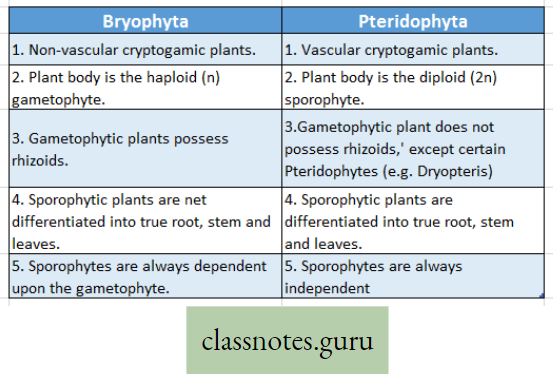
Flowering plants or Phanerogams Definition: Those plants whose body is composed of roots, stems, and leaves and produce fruits and seeds are called flowering plants or Phanerogams. (Gr Phoneros, visible well-organized vascular system.
Flowering plants are divided into the following two groups;
Examples:
- Gymnosperms and
- Angiosperms

Gymnosperms (Gr. Gymnos, naked, sperma, seed): The seeds of these plants remain exposed (naked), not covered using fruit. For that reason, they are termed as naked seeded plants, for example, Cycas, Pinus, and Gnetum.
Angiosperms (Gr. Angios, covered; Sperma, seed): The seeds of these plants remain covered using fruits. For that reason, they are termed closed-seeded plants, for example, Mango, Peas, and Wheat.
Difference between Angiospefms and Gypinosperms
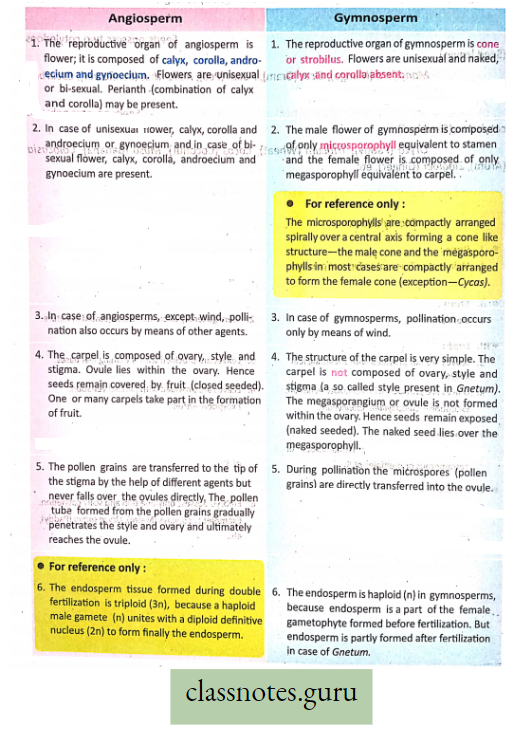
Angiospermic plants are divided into two groups, for example, Dicotyledonous and Monocotyledonous.
- Dicotyledonous (Gr. Di, two; cotyledon, seed leaves): Seeds possess two cotyledons (Seed leaves).
- Examples— Mongifero (Mango), Cicer (Gram), Pisum (Pea), Helianthus (Sunflower), Cucurbita, (Gourd), etc.
- Monocotyledonous (Gr. Mono, single; cotyledon, seed leaves): Seeds possess only one
cotyledon (Seed leaf).- Examples— Oryzo (Paddy), Triticum (Wheat), Cocos (Coconut), Musa (Banana), Colocasia (Arum), Zingiber (Ginger), etc.
Morphological Comparison of Dicotyledons and Monocotyledons:
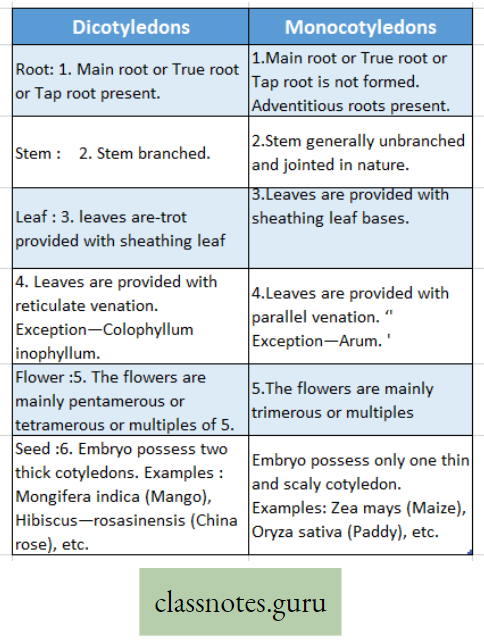
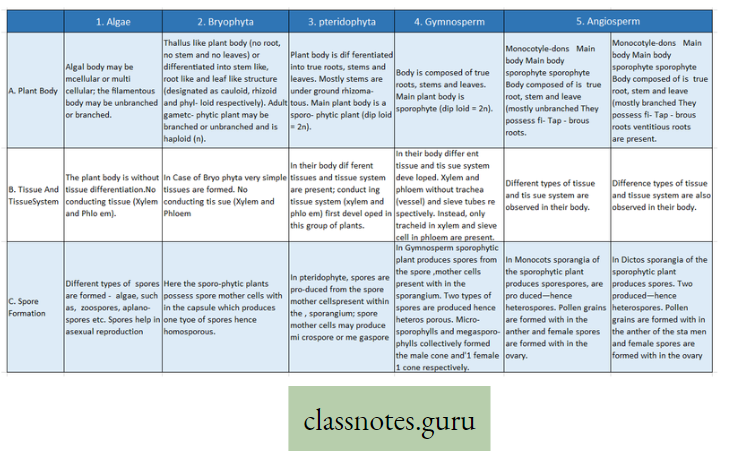
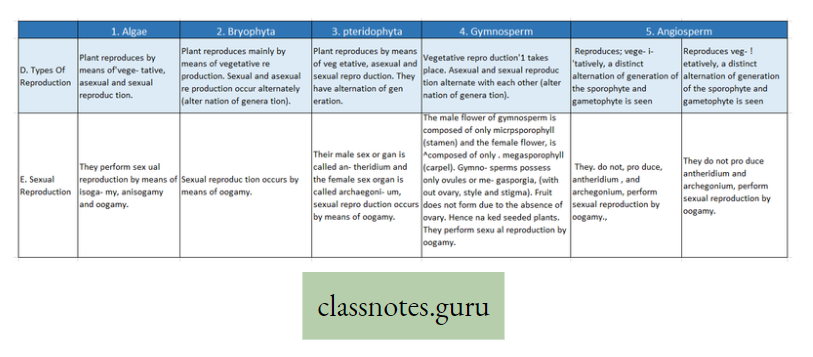

Classification Of Kingdom Animalia
How different animals are similar and different from each other Introduction: You have observed a great variety of animals living on earth.
- They are interdependent with one another and with the plant kingdom. Great varieties of animals comprise the biodiversity of the environment.
- Over a million species of animals have been described till now but they cannot be studied separately.
- Hence, the need for classification becomes very important.
- Based on similarities and dissimilarities of characteristic features, animals are classified into several groups.
- With the help of classification, an animal could be identified into a definite group, and its evolutionary position could be resolved.
Some useful terms related to animal classification Symmetry: The regular arrangement of body parts following a definite pattern is known as symmetry. The animals may be symmetrical (for example Sponges, etc.), bilaterally symmetrical (for example Insects, Fish, etc.), or radially symmetrical (for example Hydra, etc).
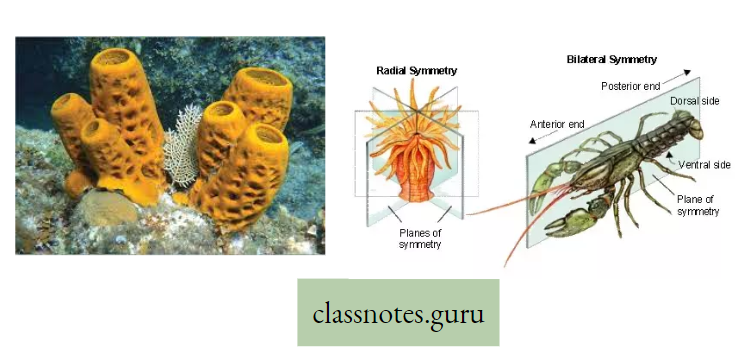
Diplobiastic and Triploblastic Organisation: In animals, during early embryonic development, if there are two layers in the embryo an external ectoderm and an internal endoderm, then the animals are called diploblastic example, Cnidaria. On the contrary, those animals having three embryonic germinal layers outer entoderm or middle mesoderm and inner endoderm are tailed as triploblastic animals’ for example, Platyhelminthes to Chordates (including man).
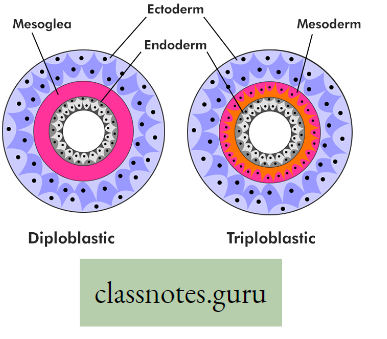
Development of organs Or systems from three germinal layers:
- Ectoderm: Nervous system, the epidermis of the skin, enamel of the tooth, sweat gland, hair, nail, etc
- Mesoderm: Connective tissue, muscle, bones, notochord, etc.
- Endoderm: Inner linings of the digestive and respiratory tube, liver, pancreas, etc.
Coelom: It is the body cavity between an alimentary canal and body wall, which is surrounded on all sides both inwardly and outwardly by mesoderm. If the body cavity is not surrounded by mesoderm, it is called a pseudocolor ExamplesAschelminthes.
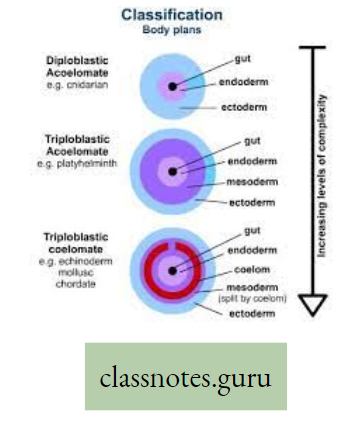
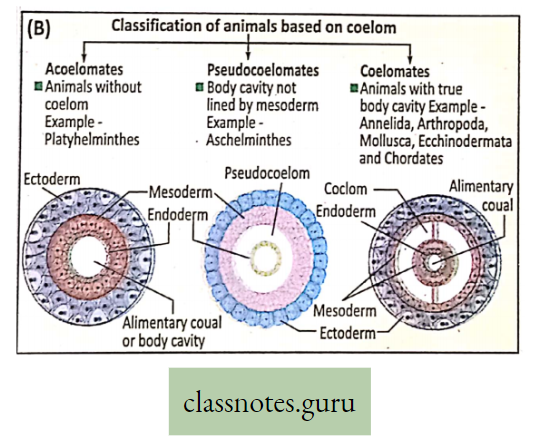
Segmentation: In some animals, the body is externally and internally divided into segments metamere-having “repetition of similar anatomical parts. This phenomenon is called segmentation metamerism Example: Earthworm.
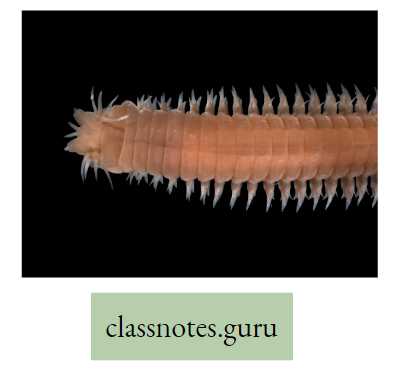
Notochord: Some animals develop a mesodermally derived rod-like structure on the dorsal side of the body during embryonic development. This structure is called notochord and the animals with notochord are called chordates. Those who do not form notochord are called nonchordates example Porifera EchinodermS.
Broad Classification of Kingdom Animalia:

Phylum 1. Porifera (Gr. Porus = Poreferre = to bear) (Pore-bearing animals)
Notochord Salient features:
- They are diploblastic, sedentary (sessile), aquatic animals.
- The whole body is perforated by numerous pores called ostia.
- Water flows through the body cavity called spongocoel which is lined by Choanocytes or Collar cells or flagellate ceil.
- The whole system is called the canal system.
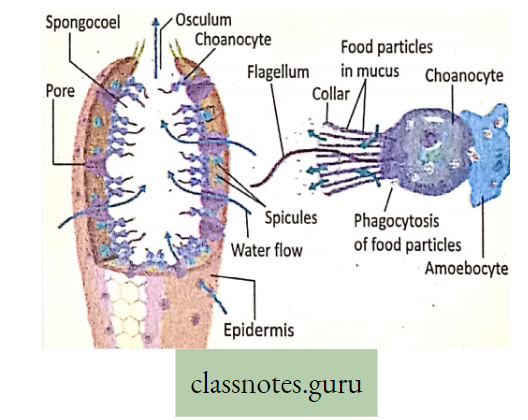
Notochord Examples: Neptune’s cup (Peterson sp.); Crown sponge (Scypha sp.)
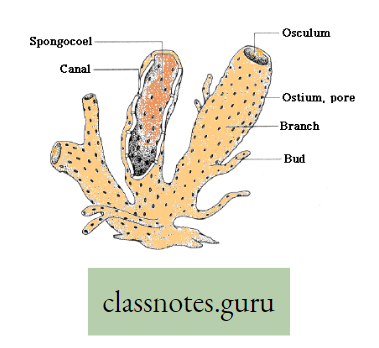
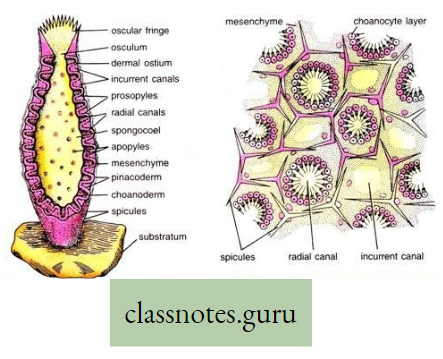
Do you know? A particular porifera is commonly called a Venous flower basket”?
Can you identify the important functions of the canal system? ‘Sponges are multicellular animals without tissue formation” How do you justify it?
Phylum 2, CriidaHa’ (Gr. Khide = nettle or spine or sting). (Animals with, sling cells).
Canal System Salient features:
- They are diploblastic animals having gastrovascular cavities.
- The body consists of a cnidoblast cell that forms a stinging apparatus called nematocyst which is the organ of offense and defense.
- The body of the animal may be Polyp (tubular body) or medusa (umbrella-shaped body).
Canal System Examples: Hydra (Hydra viridis); Jellyfish (Aurelia sp.).
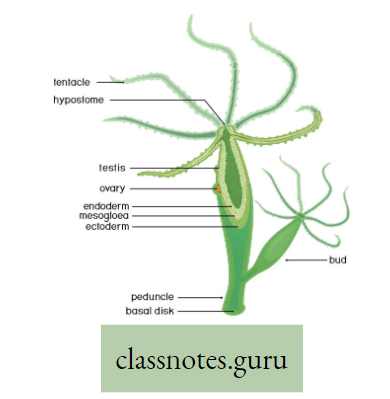
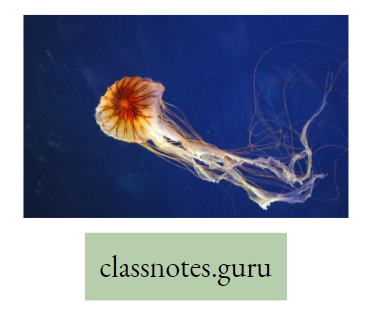
Cnidaria (Physalia) is called ‘Portuguese man – of – war’ Why?
Phylum 3. Ctenopiiora (Gr. knows = comb; photos = bearing) (Animals with comb plate)
Ctenopiiora Salient features :
- They are diploblastic animals.
- The body is formed of eight ciliated comb plates that act as locomotory organs.
- They have some special adhesive collision between the tentacles known as coil blast cells or Lasso cells.
Ctenopiiora Examples: Hormiphora (Hormiphora sp.); Beroe (Beroe sp.)
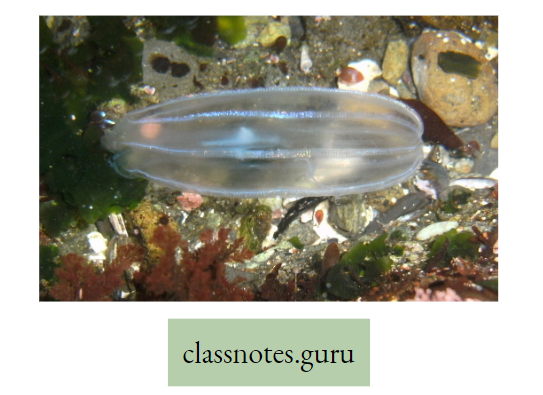
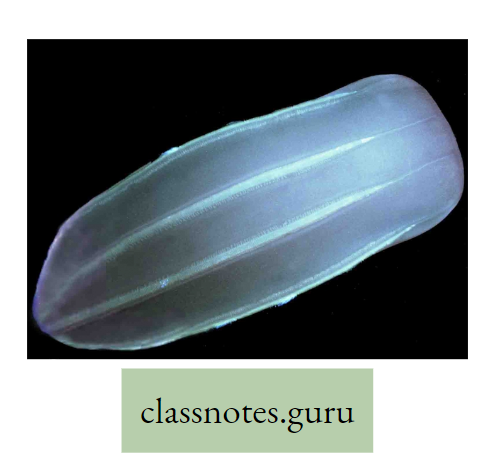
- The smallest major phylum of the animal kingdom is Ctenophora. ; java yi Ctenophores are commonly known as ‘sea walnut’.
- Please know from your teacher Ctenophores exhibit bioluminescence” What
does it mean? - Do you-know-that’Ctiidaria and ctenophore-together called Coelenterata in the old Classification of animal-kingdom
Phylum 4. Piatyheimintries (Gr. Piaijys = flat; hernias = worms) (Flatworm or tapeworm)
Piatyheimintries Salient features:
- The body is thin, dorsoventrally f.vjvflat, triploblastic animals (First triploblastic animal in the evolution of the animal kingdom).
- Bilaterally symmetrical, acoelomate body hermaphrodite animals (bisexual animal)
- Execution by Flame Cell
Piatyheimintries Examples: Liver fluke (Fasciola hepatica); Pig tapeworm [Taenia solium)
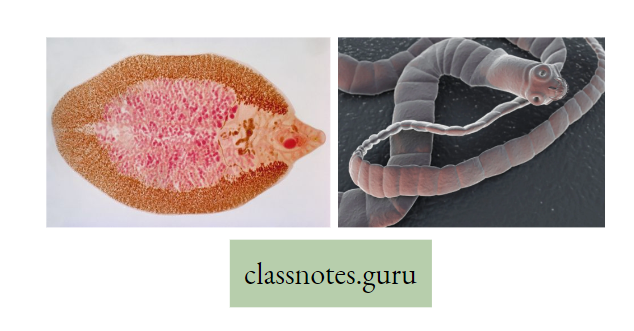
Phylum 5. Nematoda or Nemathelmipthes or Aschelrninthes (Gr. IMernatos = thread ) (Roundworm)
Nematoda Salient features:
- Long cylindrical body with an alimentary canal that starts in the mouth and ends in the anus.
- Pseudocoelomste animals with bodies covered with cuticles.
- Generally, the sexes are separate.
Nematoda Examples: Roundworm (Ascaris lumbricoides) Filaria worm (Wuchereria bancrofti)
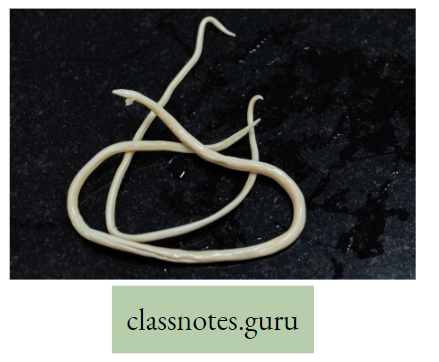

Write two common causes of infection of roundworm in children.
Phylum 6. Annelida (L. Annulus – ring; eidos = form) (Animals with ringlike body segments)
Annelida Salient features:
- Elongated. body with numerous, ringlike segments called metamere.
- Triploblastic animals with true coelom.
- Excretion bynephrkiia.
Annelida Examples:
- Earthworm
- Leech

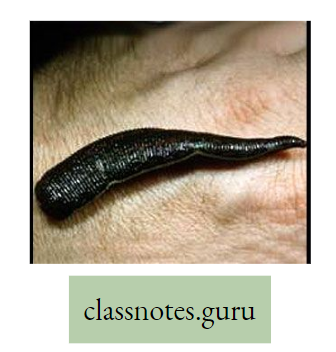
One special annelids is called “sea mouse’. Do you know its scientific name?
What is the importance of coelom? In this body cavity different viscera! and abdominal organs (apart from the alimentary canal) are accommodated.
Phylum 7. Arthropods (Gr. Arthron = joint; pods = foot) (Animals with jointed appendage)
Arthropods’ Salient features :
- Appendages are attached to the body by Arthrodia! membrane.
- Open blood circulation within the body cavity is called hemocoel.
- The body is covered with a chitinous exoskeleton.
Arthropods Examples:
- Cockroach [Periplaneta americana)
- Tiger Prawn (Penaeus monodon)
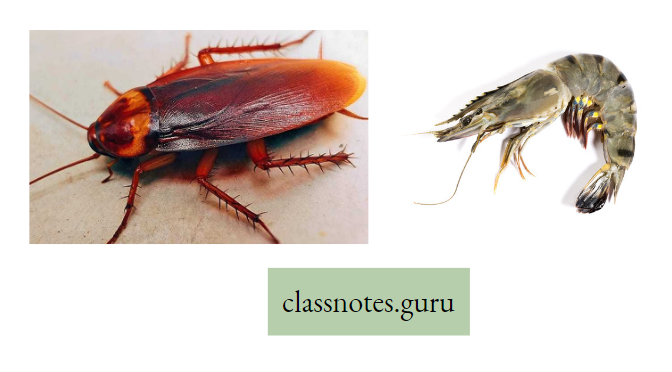
Besides the main axis of the body (Head, Thorax, and Abdomen), all additional organs (attachments) are called appendages.
Arthropods are the largest phylum of the animal kingdom. Make a list of insects of your own. locality. Identify in which season they flourish in number. Write a small note on economically important insects and their uses. Have you seen the scorpion in Satyajit Roy’s ‘Sonar Keila’?
For reference only:

Phylum 8. Mollusca (L. Mollis = Soft): (Soft unsegmented body covered with a calcareous exoskeleton)
Mollusca Salient features:
- Soft, unsegmented bodies in the animals.
- The body is covered with hard calcareous exoskeleton in most of them.
- The visceral mass is enclosed by a muscular fold called a mantle.
Mollusca Examples:
- Apple snail (Pila globosa)
- Octopus (Octopus lentus)
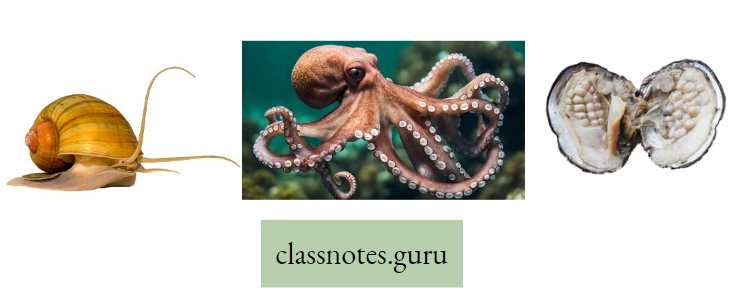
Pearl is produced by pearl oyster which is a Mollusca. Do you know what is the major component of a pearl? Octopus is commonly known as ‘devil fish’.
What is the common name of Loligo? Please remember Phylum Mollusca is the second largest phylum of the animal kingdom.
Do you remember octopus ‘Paul’, the extraordinary predictor?
Phylum 9. Echmodermata (L. Echinos = spine; derma = skin) (Animals with calcareous spines in the skin)
Echmodermata Salient features:
- The body is covered with skin having hard calcareous spines or ossicles.
- Exclusively marine with pentamerous radial symmetry
- Presence of special water vascular system or ambulacral system with tube feet.
Echmodermata Examples:
- Starfish (Asterias rubens)
- Sea cucumber (Cucumaria frondosa)
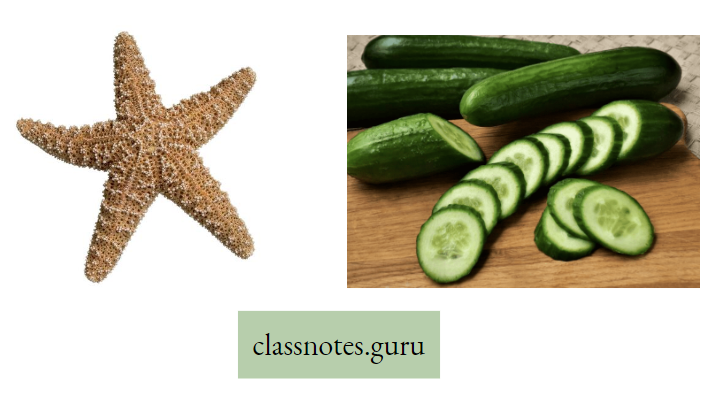
Difference between Diploblastic and Triploblastic animals:
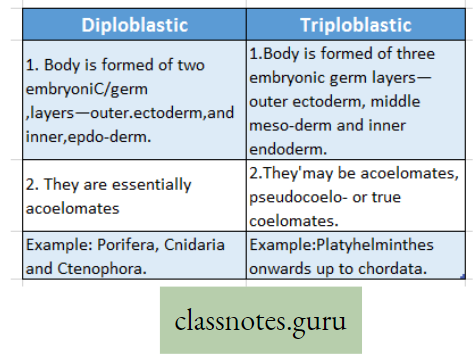
Comparison between Cnidaria and Ctenophora :
- Both of them are diploblastic.
- Almost all of the marine animals.
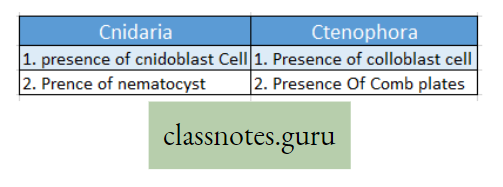
Comparison between Platyhelminthes and Aschelminthes
Platyhelminthes and Aschelminthes Similarities: Almost all of them are parasitic
Platyhelminthes and Aschelminthes Difference
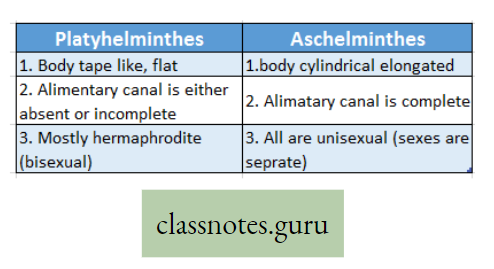
How is Porifera different from other animals? Porifera is multicellular like other animals but Porifera does not form any tissue hence all the cells are almost independent and live together like a colony of cells. In other multicellular animals. number of cells together form a tissue having a specific structure and function.
Difference between Coelomata And Psedocoelomata
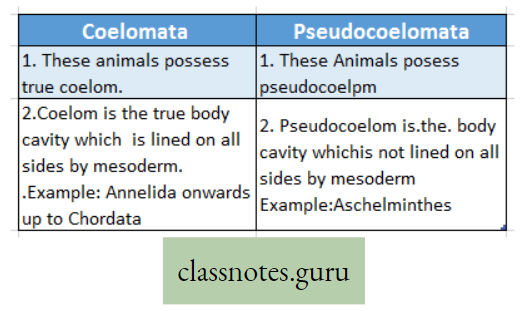
Difference between Annelida and Arthropoda.
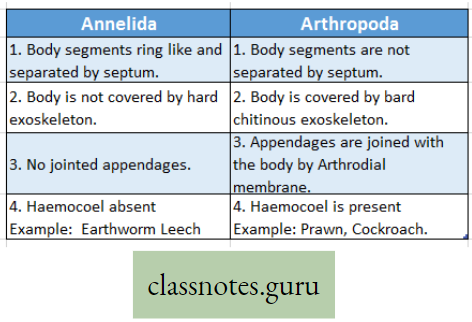
Salient features:
- Worm-like marine animals, bilaterally symmetrical, triploblastic.
- The body is cylindrical and is composed of a proboscis, collar, and a long trunk.
- A notochord-like structure called stomochord is present.
Examples: Balanoglossus sp, Saccoglossus sp.
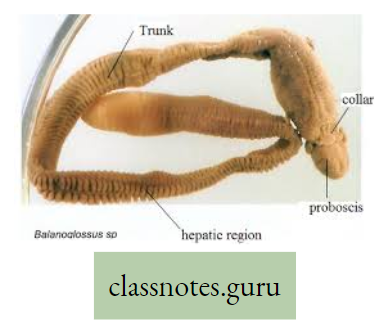
Do you know previously Hemichordata was included under Chordata but now it is ordered as a separate phylum and is not included under Chordata?

Example: All vertebrates including human beings
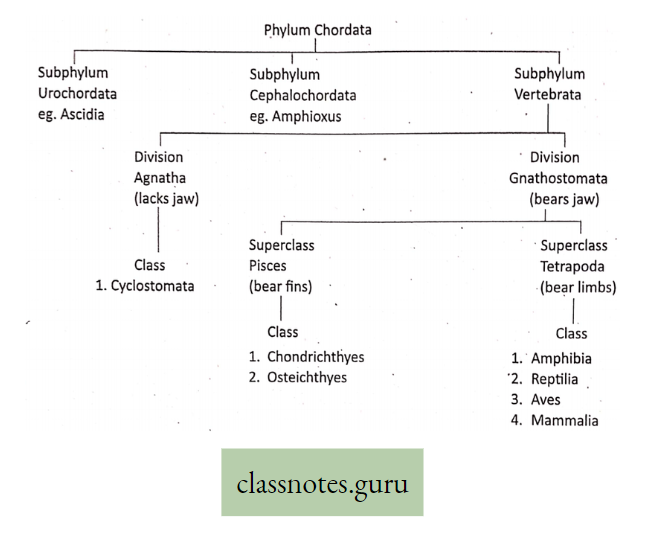
- “All vertebrates are chordates but all chordates are not vertebrates please reflect on the statement.
- Protochordata = Subphylum Urochordata + Subphylum Cephalochordata.
Subphylum Urochordata :
Subphylum Urochordata Salient features :
- Two openings on the body surface mouth and atriopore
- Notochord is present only in larval tail
- Larva undergoes retrogressive metamorphosis to form an adult.
For reference only: Metamorphosis is the process by which a larva undergoes structural, functional, physiological, and biochemical changes to be gradually transformed into an adult. If a simple larva is transformed into a complex adult, it is called progressive metamorphosis (for example caterpillar →butterfly).
On the contrary, if a complex larva is transformed into a simple adult, the process is called retrogressive metamorphosis (for example Tadpole larva, Ascidia).
Subphylum Urochordata Example: Ascidia sp. Salpa sp.
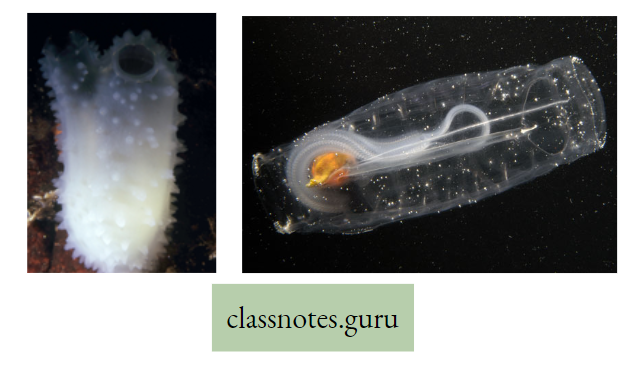
Subphylum Cephalochordata (Acraniata):
Subphylum Cephalochordata Salient features:
- Notochord extends from head to tail region and is persistent throughout life.
- Fish like marine animals,
- shaped myotome muscles are present.
Subphylum Cephalochordata Example: Amphioxus sp, Asymmetron sp.,
Subphylum Vertebrata (Craniata):
Subphylum Vertebrata Salient features:
- Presence of endoskeleton made of bones and cartilage.
- Presence of cranium or brain box that accommodates brain.
- Presence of dorsal vertebral column formed of vertebrae.
Subphylum Vertebrata Examples: Shark, Rohu, Frog, Lizard, Birds, Guineapig, etc.
Division Agnatha : (A = without; gnathos = Jaw) (Jawless animal)
Salient features :
- Mouth is circular (Cyclostomata : Cycios = circular; stoma = mouth)
- Absence of surrounding mouth.
- No paired fins and fins are without fin rays.
Examples:
- Lamprey (Pctromyzon marinus)
- Hag fish (Myxine glutinosa)
- Division Gnathostomata : (Gnathos = jaw; stoma = mouth)(Animals with jaw)
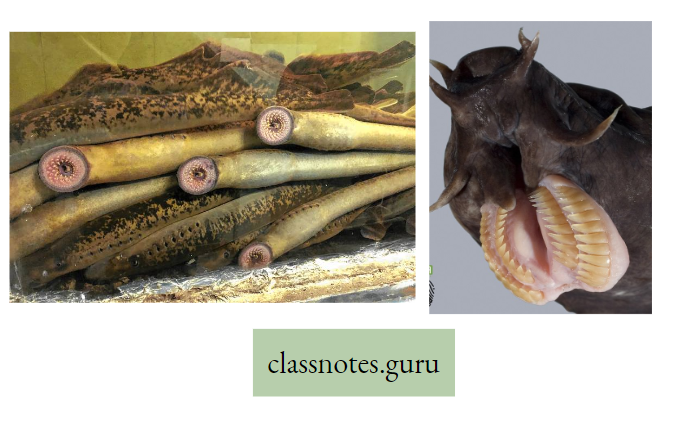
Salient features:
- The mouth is guarded by the upper and lower jaw.
- Skeletons are mostly made of bones.
- Respiration by i; ills or lungs
Example: Fish, Amphibia, Reptilia, Aves, Mammalia.
Class 1. Chondrichthyes (Gr. chondromas = Cartilage; icthyes = Fish) (Fishes having cartilaginous skeletons)
Chondrichthyes Salient features:
- The endoskeleton completely cartilaginous.’s; bone absent
- Gill slits are without operculum; the mouth is centrally placed.
- In marine animals where the body is covered with placoid scales; no air bladder.
Chondrichthyes Example:
- Dogfish shark (Scoliodon sp)
- Sting ray (Trygon sp)
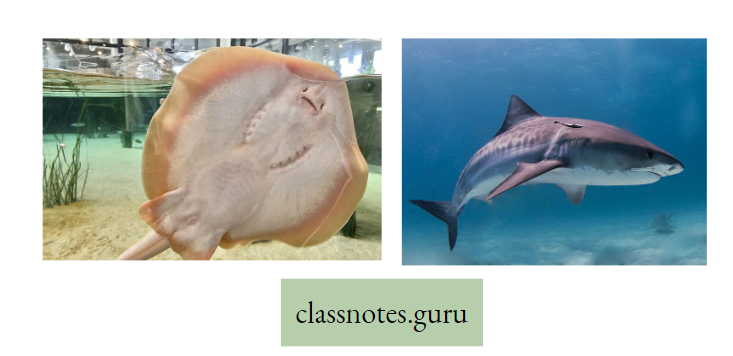
Electric ray fish can cause electric shock for defense. Do you know? Famous Australian animal lover Steve Irwin died by the sting of a sting ray.
Class 2. Osteichthyes (Gr. Osteon ~ Bone; icthyes = Fish) (Bony fish)
Osteichthyes Salient features:
- Skin is covered with cycloid or ctenoid scales.
- Gills are covered by operculum presence of ait blades to maintain hydrostatic balance.
- Two chambered venous hearts that always contain deoxygenated blood.
Osteichthyes Example:
- Rohu Fish (Labeo rohita)
- Katla Fish (Catla catla)

You should know fish oil contains HDL (High-Density Lipoprotein) which is very good for our hearts. HDL is also called good cholesterol.
Class 3. Amphibia (Gr. Amphi = both; bios = life)
(Animal that can live both on land and in? water)
Amphibia Salient features:
- Skin moist, glandular, and inked.
- Heart three chambered two auricles and one ventricle.
- For sexual reproduction and larval life, water is needed.
Amphibia Example:
- Frog (Rana tiger in a)
- Salamander (Ambystoma sp)

Do you know Axolotl larva can reproduce even in larval conditions—a very important specialty known as Neoteny or Paedogenesis? ‘
Class 4. Reptilia (L. Repere = to creep) (Vertebrates with creeping or crawling habit)
Reptilia Salient features:
- Presence of two pairs ofoentadactyle limbs with claws that help in crawling locomotion.
- Dry skin covered withcornfnedepidermai scales.
- Heart three and a half chambered (four-chambered in crocodile).
Reptilia Example:
- Garden Lizard (Calotes versicolor)
- Cobra (Naja naja) Tautonym

Salient features:
- Presence of a pair of mammary glands which is enlarged in females. This gland is a modified sweat gland.
- The body is covered with hair a pair of external ears or pinna is present.
- Heart completely four-chambered; matured RBC nonnucleated; diaphragm separates thorax and abdomen.
Example : Tiger (Panthera tigris) Man (Homo sapiens sapiens)
(Latin, Homo = man ; Sapiens = wise) This means Very wise man
The most fascinating extinct animal of the Jurassic period Dinosaurus (Terrible lizard) belonged to the class Reptilia.
For reference only:
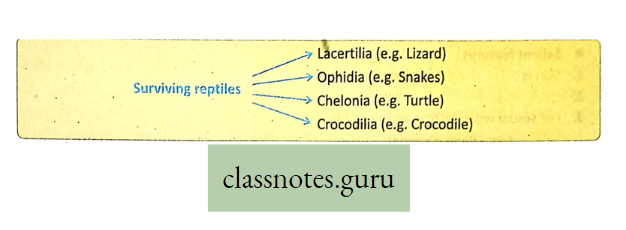
Class Aves (L. Avis = bird)
(Common flying vertebrates)
Salient features:
- The body is covered with feathers and the forelimb is modified into wings for flight.
- Bones are hollow, pneumatic, and lighter in weight; the heart is completely four-chambered.
- Presence of horny, hard beak without teeth.
Example: Pigeon (Columba livia)
Peacock (Pavo cristatus)

- A penguin is a bird from Antarctica, that cannot fly.
- Do you observe any peculiarity of ostrich?
- Do you know the ostrich egg is the largest single animal cell”?
- Running birds are called Ratitae and Flying birds are called carinatae.
Class 6. Mammalia (L. Mammalis = breast) (The highest evolved group of the animal kingdom)
Mammalia Salient features:
- Presence of a pair of mammary glands which is enlarged in females. this gland is a modified sweat gland.
- The body is covered with hair pair of external ear pinna prevent
- Heart completely four-chambered matured RBC nonnucleated diaphragm separates thorax and abdomen.
Mammalia Example: Tiger(pantheraa tigris)
Man(homo Sapiens sapiens))Latin homo =man;sapiens =wise)This means very wise man
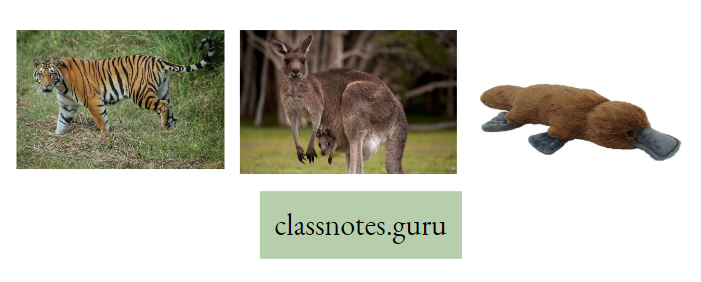
- Most of the mammals are viviparous.
- Do you know the name of any mammal that lays eggs?
- ‘Bat is a volant mammal’ Can you justify the statement?
- Whales and dolphins are aquatic mammals and not fish.
- Class Mammalia is divided into three subgroups
- Protothers (egg-laying mammals) example Platypus, Echidna
- Metatheria (females have marsupium) example Kangaroo
- Eutheria (females develop placenta during pregnancy) example Tiger, Man
The animals that lay eggs are called oviparous(for example Fish, Amphibia, Reptilia, Aves), and those who give birth to young ones directly are called viviparous(for example Mammalia).
Difference between Nonchordnta and Chordata

Difference Between Chondrichthyes And Osteichtyes

Difference between Amphibia and Reptilia.

“All vertebrates are chordates but all chordates are not vertebrates” justify the statement. In all vertebrates, chordate features are present in early embryonic life.
- Thus, there is a notochord which is gradually replaced by the vertebral column in the course of development.
- They have pharyngeal gill slits which may be persistent or replaced by lungs so all vertebrates are chordates.
- But all chordates are not vertebrates for example, in Urochordata and cephalochordate, the notochord is persistent throughout life and is never replaced by vertebra columns.
- Hence urocherdates and cephalochordates are chordates but not vertebrates.
